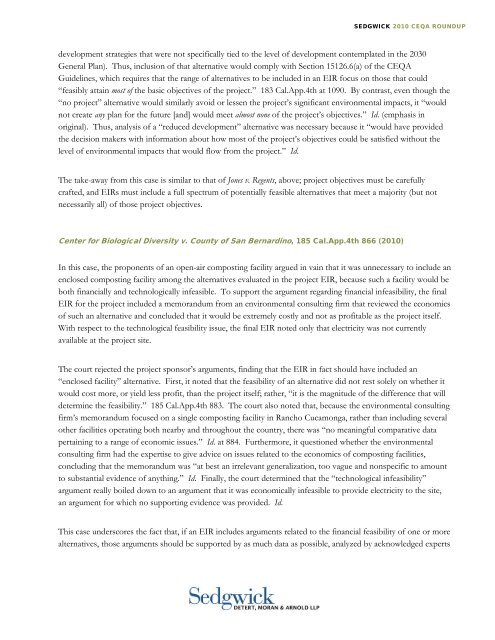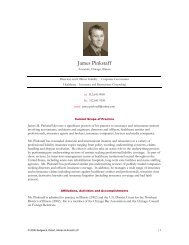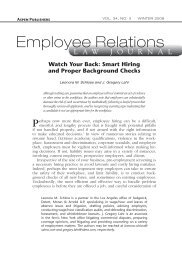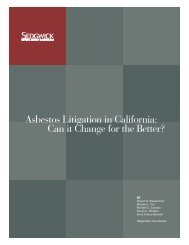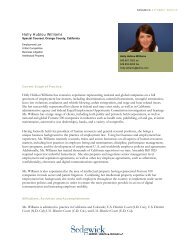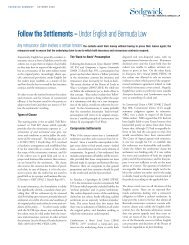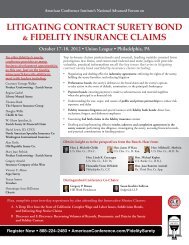Download Case Summaries in PDF Format - Sedgwick LLP
Download Case Summaries in PDF Format - Sedgwick LLP
Download Case Summaries in PDF Format - Sedgwick LLP
Create successful ePaper yourself
Turn your PDF publications into a flip-book with our unique Google optimized e-Paper software.
SEDGWICK 2010 CEQA ROUNDUP<br />
development strategies that were not specifically tied to the level of development contemplated <strong>in</strong> the 2030<br />
General Plan). Thus, <strong>in</strong>clusion of that alternative would comply with Section 15126.6(a) of the CEQA<br />
Guidel<strong>in</strong>es, which requires that the range of alternatives to be <strong>in</strong>cluded <strong>in</strong> an EIR focus on those that could<br />
“feasibly atta<strong>in</strong> most of the basic objectives of the project.” 183 Cal.App.4th at 1090. By contrast, even though the<br />
“no project” alternative would similarly avoid or lessen the project’s significant environmental impacts, it “would<br />
not create any plan for the future [and] would meet almost none of the project’s objectives.” Id. (emphasis <strong>in</strong><br />
orig<strong>in</strong>al). Thus, analysis of a “reduced development” alternative was necessary because it “would have provided<br />
the decision makers with <strong>in</strong>formation about how most of the project’s objectives could be satisfied without the<br />
level of environmental impacts that would flow from the project.” Id.<br />
The take-away from this case is similar to that of Jones v. Regents, above; project objectives must be carefully<br />
crafted, and EIRs must <strong>in</strong>clude a full spectrum of potentially feasible alternatives that meet a majority (but not<br />
necessarily all) of those project objectives.<br />
Center for Biological Diversity v. County of San Bernard<strong>in</strong>o, 185 Cal.App.4th 866 (2010)<br />
In this case, the proponents of an open-air compost<strong>in</strong>g facility argued <strong>in</strong> va<strong>in</strong> that it was unnecessary to <strong>in</strong>clude an<br />
enclosed compost<strong>in</strong>g facility among the alternatives evaluated <strong>in</strong> the project EIR, because such a facility would be<br />
both f<strong>in</strong>ancially and technologically <strong>in</strong>feasible. To support the argument regard<strong>in</strong>g f<strong>in</strong>ancial <strong>in</strong>feasibility, the f<strong>in</strong>al<br />
EIR for the project <strong>in</strong>cluded a memorandum from an environmental consult<strong>in</strong>g firm that reviewed the economics<br />
of such an alternative and concluded that it would be extremely costly and not as profitable as the project itself.<br />
With respect to the technological feasibility issue, the f<strong>in</strong>al EIR noted only that electricity was not currently<br />
available at the project site.<br />
The court rejected the project sponsor’s arguments, f<strong>in</strong>d<strong>in</strong>g that the EIR <strong>in</strong> fact should have <strong>in</strong>cluded an<br />
“enclosed facility” alternative. First, it noted that the feasibility of an alternative did not rest solely on whether it<br />
would cost more, or yield less profit, than the project itself; rather, “it is the magnitude of the difference that will<br />
determ<strong>in</strong>e the feasibility.” 185 Cal.App.4th 883. The court also noted that, because the environmental consult<strong>in</strong>g<br />
firm’s memorandum focused on a s<strong>in</strong>gle compost<strong>in</strong>g facility <strong>in</strong> Rancho Cucamonga, rather than <strong>in</strong>clud<strong>in</strong>g several<br />
other facilities operat<strong>in</strong>g both nearby and throughout the country, there was “no mean<strong>in</strong>gful comparative data<br />
perta<strong>in</strong><strong>in</strong>g to a range of economic issues.” Id. at 884. Furthermore, it questioned whether the environmental<br />
consult<strong>in</strong>g firm had the expertise to give advice on issues related to the economics of compost<strong>in</strong>g facilities,<br />
conclud<strong>in</strong>g that the memorandum was “at best an irrelevant generalization, too vague and nonspecific to amount<br />
to substantial evidence of anyth<strong>in</strong>g.” Id. F<strong>in</strong>ally, the court determ<strong>in</strong>ed that the “technological <strong>in</strong>feasibility”<br />
argument really boiled down to an argument that it was economically <strong>in</strong>feasible to provide electricity to the site,<br />
an argument for which no support<strong>in</strong>g evidence was provided. Id.<br />
This case underscores the fact that, if an EIR <strong>in</strong>cludes arguments related to the f<strong>in</strong>ancial feasibility of one or more<br />
alternatives, those arguments should be supported by as much data as possible, analyzed by acknowledged experts


